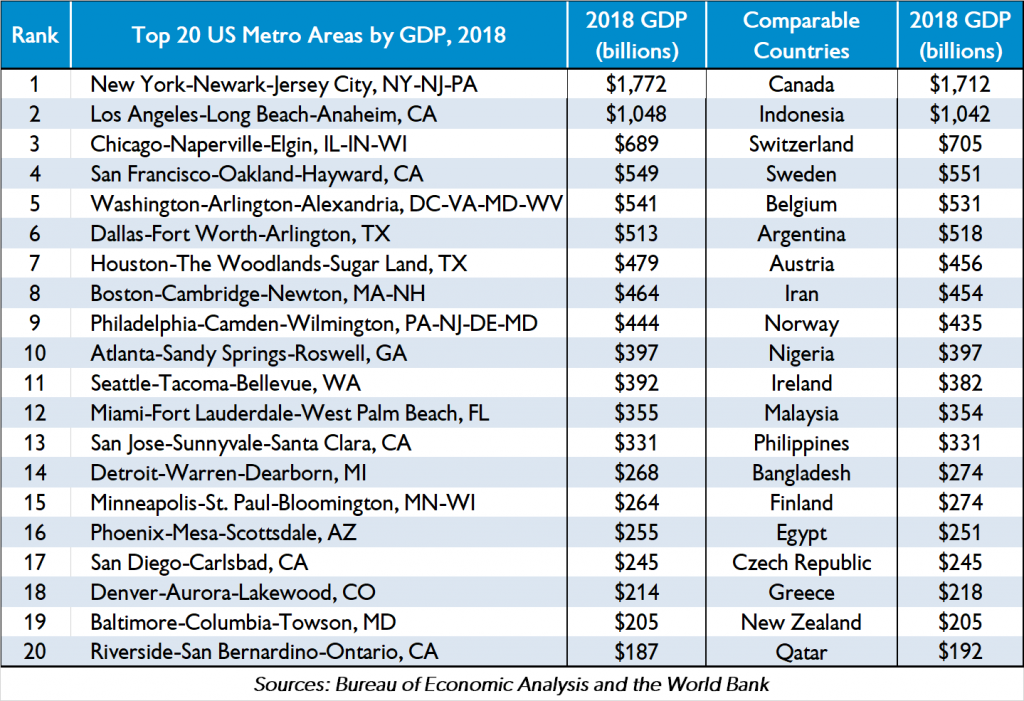
The table and map above help to put America’s ridiculously large $20.6 trillion economy (Gross Domestic Product in 2018) into perspective by comparing America’s 20 largest metro area economies in 2018 (based on data released last week by the Bureau of Economic Analysis) to the economies of entire countries with similar levels of Gross Domestic Product in 2018 (World Bank data via Wikipedia). Here are some interesting facts about the size of US metro area economies:
- America’s largest metro economy – the New York City area — produced 3.5% more economic output last year ($1.77 trillion of GDP) than the entire country of Canada ($1.71 trillion of GDP) and the New York City metro area as a separate country would have been the 10th largest economy in the world behind No. 9 Brazil in 2018 ($1.87 trillion GDP). Amazingly, to produce approximately the same amount of economic output requires a labor force of 20.4 million in Canada (according to World Bank data here) that is roughly twice the size of NYC’s labor force of about 10 million (according to BLS data here).
- The LA metro area, the second-largest US metro economy, produced just slightly more economic output ($1.05 trillion of GDP) in 2018 than the entire country of Indonesia ($1.04 trillion of GDP) and LA would have been the 16th largest economy in the world last year as a separate country behind No. 15 Mexico. To produce roughly the same amount of GDP, the size of Indonesia’s labor force (133 million) is nearly 20 times greater than the LA metro’s labor force of 6.8 million!
- Chicago is America’s third-largest metro economy and in 2018 its GDP of $689 billion was almost the same size as Switzerland’s GDP of $705 billion, and it would have ranked as the 21st largest national economy in the world last year.
- America’s three largest metro areas (NYC, LA, and Chicago) in 2018 together produced $3.46 trillion in GDP, which was slightly less than the entire economic output of Germany at $4.0 trillion, and those three US metros as a separate national economy would have ranked as the fifth-largest economy in the world last year behind Germany. To generate about the same amount of economic output last year required a labor force in Germany (43.3 million) that is about twice the size of the combined labor forces of NYC, LA, and Chicago (21.7 million).
- The top six largest US metro areas (NY, LA, Chicago, Dallas, DC, and San Francisco) last year produced $5.1 trillion of economic output (GDP) last year, and those six metro areas combined as a separate country would have been the third-largest national economy in the world, ahead of No. 4 Japan’s $5.0 trillion GDP in 2018.
- It’s also interesting to note that roughly half of America’s GDP last year ($10.3 trillion) was produced in the country’s 24 largest metro areas: the 20 metros in the table above, plus St. Louis, Charlotte, Portland, and Tampa.
MP: This comparison provides another demonstration of how ridiculously large America’s $20.6 trillion economy really is by showing that the economies of America’s largest metropolitan areas are equivalent in economic size to the GDP of entire large countries (see my earlier comparison on CD of the economic size of US states to entire countries with comparable GDPs in 2018). It’s mind-boggling to think that the economy of the New York City metro area is larger than Canada’s economy with a labor force half the size, and the economy of the LA metro is almost as large as the entire Indonesian economy with a labor force that is 95% smaller. Moreover, each of America’s 17 largest metro economies as separate nations are big enough to rank in the world’s 45 largest economies and all 20 US metro areas in the table above would rank in the world’s 54 largest economies. Perhaps it’s a demonstration of National Economic Council Director Larry Kudlow’s mantra that he used to frequently quote on his CNBC show that “free-market capitalism is the best path to prosperity” because it was largely free markets, free trade, free enterprise, and capitalism that propelled the US from a minor British colony in the 1700s into a global economic superpower and the world’s largest economy, with dozens of metro areas that now produce economic output equivalent to the GDP of some of the world’s largest economies.
Special thanks to Kevin Kiefer for his assistance collecting the data for this post and to Allison Torban for creating the two maps above.
The post Understanding America’s enormous $20.6T economy by comparing US metro area GDPs to entire countries appeared first on American Enterprise Institute – AEI.



